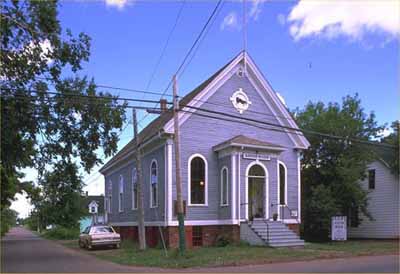Alberton Court House National Historic Site of Canada
Alberton, Prince Edward Island

General view of the place
(© Parks Canada Agency/Agence Parcs Canada, 1987.)
Address :
457 Church St. (east of Howland St.), Alberton, Prince Edward Island
Recognition Statute:
Historic Sites and Monuments Act (R.S.C., 1985, c. H-4)
Designation Date:
1981-01-15
Dates:
-
1877 to 1878
(Construction)
-
1878 to 1978
(Significant)
Event, Person, Organization:
-
Prince Edward Island Superintendent of Public Works, 1873
(Architect)
-
James Wiggins and Sons
(Builder)
Other Name(s):
-
Alberton Court House
(Designation Name)
Research Report Number:
Court House Study
Plaque(s)
Existing plaque: 457 Church St. (east of Howland St.), Alberton, Prince Edward Island
Soon after the passage of Prince Edward Island's County Courts Act in 1873, a series of six circuit court houses was erected in the province's small town and villages. Under the direction of the Provincial Board of Works, they were built according to a standard plan consisting of a rectangular main body dominated by a single room, with a porch at the gable-end entrance, like many rural schools and churches. Of the four circuit court houses that remained in 1980, the Alberta building, erected in 1877 by John Wiggins and Sons, is both representative and the most ornate of this rural type.
Description of Historic Place
The Alberton Court House is a simple wooden hall under a steeply pitched roof. With its entry on a gable end, the building evokes the image of a pioneer church rather than the courthouse that it was. Located in Alberton, Prince Edward Island, it is notable for its Neo-classical composition and graceful proportions. The designation refers to the building on its legal property. It now serves as the Alberton Museum.
Heritage Value
Alberton Court House was designated a National Historic Site in 1980 because it is both representative and the most ornate of a series of six circuit court houses erected according to a standard plan, soon after the passage of Prince Edward Island's County Courts Act in 1873.
All these early circuit court houses were small single storey pitched roof buildings constructed to a standard plan with a porch/vestibule and an open interior court room. The Alberton Court House was built in 1877-1878 by James Wiggins and Sons of Alberton to the standard plan designed by the Prince Edward Island Superintendent of Public Works in 1874-1875. The basement of the Alberton Court House contained half a dozen cells as well as accommodation for a keeper. The building ceased to be used as a court house in the late 1970s and began to be used as the local museum in 1980.
The heritage value of Alberton Court House National Historic Site lies in those aspects of its design that conform to the standard plan - its single storey form, open interior layout and porch/vestibule - as well as those that mark this building as distinctive - its basement gaol, its Neo-classical composition and graceful proportions.
Source: Historic Sites and Monuments Board of Canada Minute, March 1980.
Character-Defining Elements
Key features contributing to the heritage value of this site include: its rectangular massing under a steeply pitched roof; its auditory hall design with an open interior volume and small rectangular entrance porch; its Neo-classical detailing, including its Roman arched window and door openings, corner pilasters, molded cornice, and oculus; its evenly spaced, tall round headed, multi-pane sash windows on the main floor and the small multi-pane barred windows with single, hinged exterior shutters of the basement; its wooden construction materials and their careful, skilled craftsmanship; surviving evidence of its original function as a courthouse and gaol, notably its open ground-floor volume and surviving layout and materials of the basement jail; surviving original fittings and furnishings, their materials, craftsmanship and finishes.